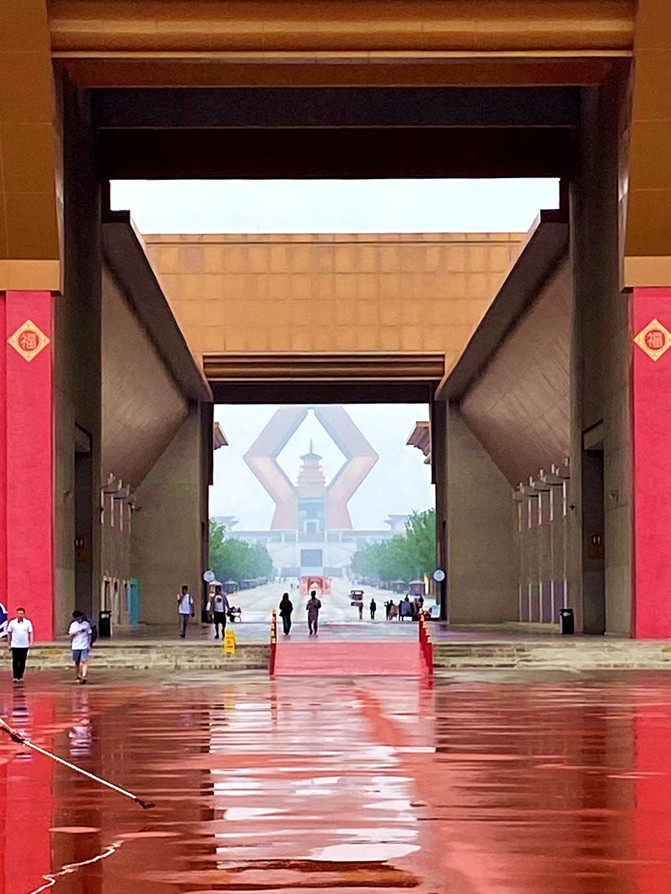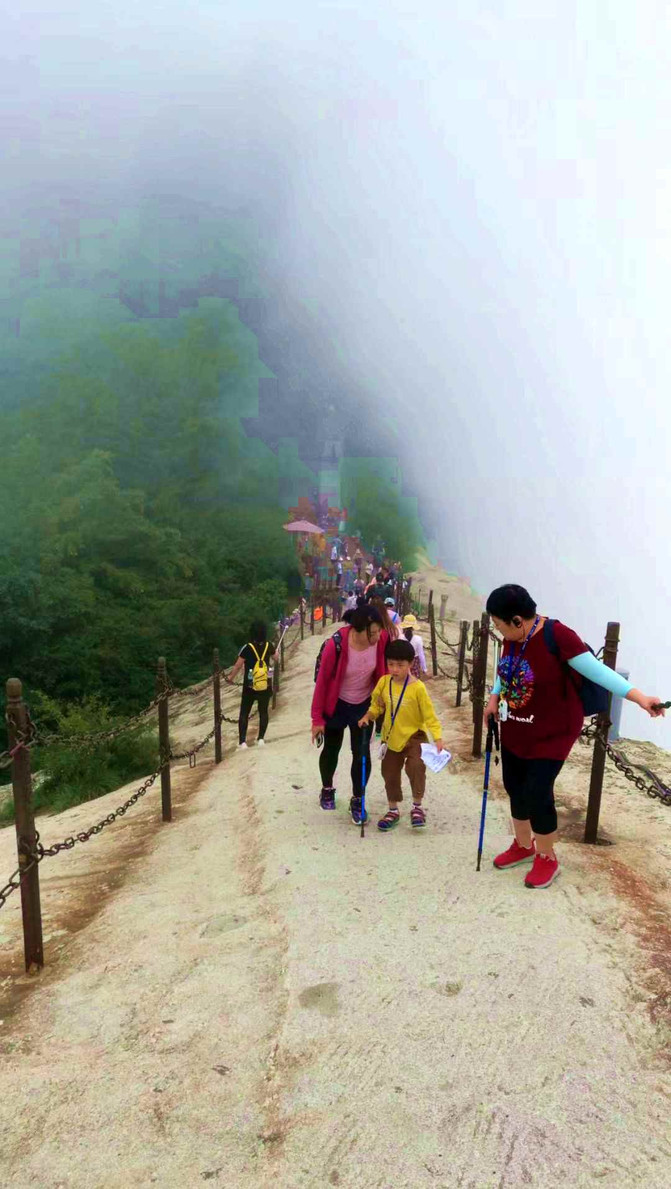Follow Lao Xia to Lintong and travel freely to Huashan.
Start traveling around Xi'an today. First go to the Qin Shi Huang Terracotta Warriors Museum. Located 1.5 kilometers east of the Mausoleum of Qin Shi Huang in Lintong District, Xi'an, the building is large in scale and unique in appearance. Trees, flowers and plants are planted in the museum area. It is clean and elegant, and the entrance to the scenic area is magnificent.



The full ticket price is 120 yuan. Qin Shi Huang Terracotta Warriors Museum is also known as the Terracotta Warriors and the Qin Terracotta Warriors. It is the burial pit for the Mausoleum of Qin Shi Huang, and together with the Mausoleum of Qin Shi Huang, it forms the Mausoleum Museum of Qin Shi Huang. The Terracotta Warriors and Horses of Qin Shi Huang are known as the eighth wonder of the world. The more than 1,000 soldier pottery figures unearthed here have different images and vivid expressions. They are a shining pearl in the history of ancient Chinese sculpture art and are known as "one of the great discoveries in the archaeological history of the 20th century."




Huaqing Palace Scenic Area is located 30 kilometers east of Xi'an, adjacent to the Terracotta Warriors. Due to its eternal hot spring resources and many historical events, it is well-known at home and abroad, and has become a landmark scenic spot for cultural tourism of the Tang Palace in China. Tickets are 120 yuan.


Huaqing Palace was a separate palace where feudal emperors traveled. Later, also known as "Huaqing Pool", is located in Lintong District, Xi'an City, Shaanxi Province. Including the original Lishan National Forest Park, together with the Summer Palace, Yuanmingyuan, and Chengde Summer Resort, are also known as China's four major royal gardens. Huaqing Palace is built against the mountains and facing the Wei River. It is large in scale and magnificent in architecture. It is dotted with towers, halls and halls all over Mount Li. It was originally named "Tangquan Palace" and later renamed Hot Spring Palace. Emperor Xuanzong of the Tang Dynasty moved Huaqing Palace, because it was located in Lishan Mountain, which was also called Lishan Palace, also known as Li Palace and Xiuling Palace. Huaqing Palace was built in the early Tang Dynasty and flourished after Emperor Xuanzong of the Tang Dynasty came to power. Emperor Xuanzong of the Tang Dynasty carefully built such a grand Li Palace that he visited here almost every October. At the end of the year, he returned to Chang 'an. After the An-Shi Rebellion, the political situation suddenly changed, and the travel of Huaqing Palace declined rapidly. Successive emperors after the Tang Dynasty rarely traveled to Huaqing Palace. Later dynasties, the royal family had maintenance, but before liberation, the soup ponds were sparse and the palaces were deserted. Huaqing Pond, the People's Government has carried out large-scale expansion since 1959 after liberation.


Next, we went to Qianling. This is one of the Eighteen Tombs of the Tang Dynasty in Guanzhong District, Shaanxi Province. It is located on Liangshan, 6 kilometers north of Qian County, Xianyang City, Shaanxi Province. It is the joint burial tomb of Emperor Gaozong of the Tang Dynasty, Li Zhi and Wu Zetian, covering an area of more than 300,000 acres. The Qianling Mausoleum was built in the first year of Guangzhai of the Tang Dynasty (684) and built in the second year of Shenlong (706). The construction method of "making a tomb according to the mountains" was adopted. The mausoleum area was modeled on the structure of Chang 'an City in the capital. In addition to the main tomb, Qianling also has 17 small burial tombs, where other royal members and meritorious officials are buried. Qianling Mausoleum is the best preserved main tomb of the 18th Tang Mausoleum, and it is also the only tomb of the Tang Mausoleum that has not been stolen. On March 4, 1961, Qianling was announced by the State Council as the first batch of national key cultural relics protection units.


In the first year of Hongdao of Emperor Gaozong of the Tang Dynasty (683), Wu Zetian appointed Wei Daijia, the minister of the Ministry of Civil Affairs, to be in charge of the Qianling project. Li Zhi was buried in August of the following year, and the Qianling project continued thereafter. In May of the second year of Shenlong of Zhongzong of the Tang Dynasty (706), Zhongzong Li Xian ordered Wu Ze to be buried in heaven. One year earlier, Emperor Zhongzong of the Tang Dynasty also pardoned the royal family who had been persecuted to death due to political issues during the rule of Wu Zetian, and reburied them, including Princess Yongtai Li Xianhui, Prince Yide Li Chongrun, and Prince Zhanghuai Li Xian. In addition, in the second year of Shenlong (706), additional tombs were built for King Xu Li Sujie, King Ze Li Shangjin, and Princess Yiyang Li Xiayu.
"Tang Huiyao" records that in the 14th year of Zhenyuan (798) of Tang Dezong, 378 houses were built during the repair of Qianling.
The Huangchao Rebellion occurred in the late Tang Dynasty. Huang Chao used 400,000 troops to dig Qianling, but he dug a ditch more than 40 meters deep, but the entrance to the tomb was not found, so he had to give up reluctantly. To this day, there is still a deep ditch on the west side of the main peak of Liangshan Mountain.
During the Five Dynasties, Wen Tao, the governor of Chongzhou in the Later Liang Dynasty, organized an army to excavate all the imperial tombs of the Tang Dynasty."If the tombs of the Tang Dynasty are within their territory, we will excavate them and take the gold treasures hidden in them... Only the wind and rain in Qianling cannot break out. "Qianling was spared due to its solid construction.


We went to Famen Temple, also known as Fayun Temple, located in Famen Town, Fufeng County, Baoji City, Shaanxi Province, China. It is known as the "ancestor of Guanzhong Pagoda Temple." It is said that Famen Temple was built in the 11th year of Emperor Ming of the Eastern Han Dynasty (68 years). In the Zhou Wei Dynasty, its original name was also called "Ashoka Temple". In the Sui Dynasty, it was renamed "Chengshi Taoist Temple". In the early Tang Dynasty, it was renamed "Famen Temple" and was known as the "Royal Temple". It became a Buddhist holy place looking up to the whole country because of the placement of the finger bones of Sakyamuni Buddha.



This is Huashan. Also known as Huashan or Donghua Mountain, it is located in Zhangyuan Township, 16 kilometers north of Qin County. The mountain is gentle and gentle, with beautiful and green mountains, with a radius of dozens of square kilometers. Only the main peak is abrupt, with an altitude of 1,300.2 meters. The trees on the peak conceal the ancient temple. The surrounding rocks have been eroded by wind and rain, and the strange rocks are jagged and as straight as knives. A poem said:"The green lotus cut out from the sky is suspected to be the first peak in Penglai. The strange rocks hang over the rocks and tigers and leopards squat, and the strange pine trees pull out the ground and fly dragons. "In addition, the mountains are full of strange flowers and grasses. Ancient temples and temples are stacked layer upon layer from top to bottom. The divine spring water at the bottom of the mountain gurgles, giving a fairy scenery. It is especially famous for its blooming camellia in spring (the Shangdang area is unique only here). In ancient times, there was "beautiful peaks and lush green", which was praised as the first of "copper leather is the eight scenic spots." To the west of the main peak, there are Jingye Nunnery, stage, pool, divine spring, stone steps, and Notre Dame Temple from bottom to top. According to the inscription, they were all rebuilt in the first year of Daoguang (1821). Shenquan contains a variety of minerals, which can replenish elements that the human body lacks. The ancients built the Temple of the Virgin Mary above it to show that the spring water was given by the Virgin Mary. Jingye Nunnery was also built in front of the temple to serve as a retreat for believers. Later, it continued to expand and build ancillary buildings such as stage.



200 meters above the Shenquan at the foot of the mountain is the mountainside. The only way you can reach the top of the mountain. The cliffs around them are very spectacular. Hitting upwards and passing through the "One Cave of Heaven" gate, it is the Zhenwu Temple. It is a wooden and stone structure, sitting north and south, with three rooms in width and depth. It has an architectural style of the Ming Dynasty. On the right side of the door, there are several steles such as "Notes on the Reading of Huashan Mountains and the Construction of Western Scenery Steles" and "Notes on the Construction of Sutra Tower". More than 10 meters on the right side behind Zhenwu Temple is the Jade Emperor Temple. It was demolished during the Anti-Japanese War and the ruins still exist. There are 3 inscriptions in the two corridors. From the rear of Zhenwu Temple to the left, you can see the peak of Huashan Mountain. A square tower-type Laojun Temple (also known as Laojun Ding) with a masonry structure is built according to the terrain. It has two floors on the outside, but inside, the pavilions are clear, the carving is excellent, and it has a strong local characteristics.


About 75 meters down the mountain from the north of the top is the Wang Xianweng Bone Temple, which is made of stone. It is said that after Wang Xian, the eminent monk who presided over the construction of mountaintop buildings in the Ming Dynasty, died, the virtuous people took clay sculptures of his bones and worshipped them in the temple, giving the temple its name. Huashan has a beautiful scenery, with temples hidden in it. Climbing on it, you can enter a fairyland. Looking down the mountain, you can have a panoramic view of the city with copper leather. A poem once praised:"The mountains are crouching on this peak, and the sky is cutting off the hibiscus and towering green. "The comprehensive restoration of Huashan scenic spots will become an important scenic spot in the Shangdang area.






There are several cableways in Huashan, which usually go up from the west peak and down from the north peak. It's more labor-saving.

This is a ladder.












There are many interesting places in Shaanxi, due to limited time. So I played these.
